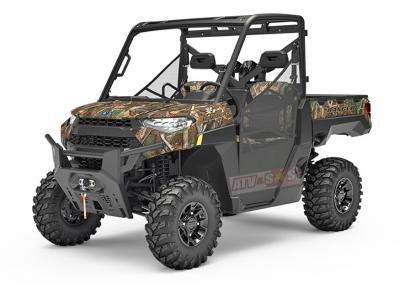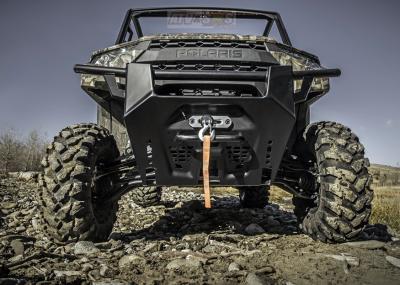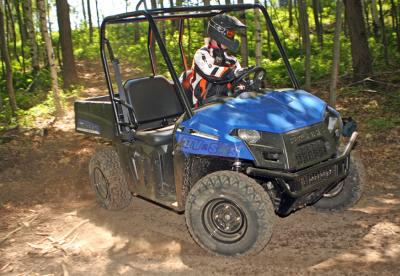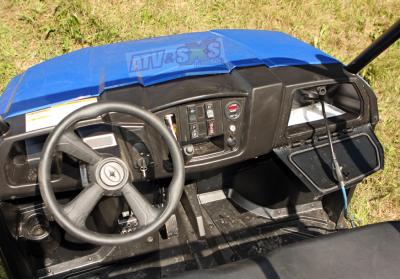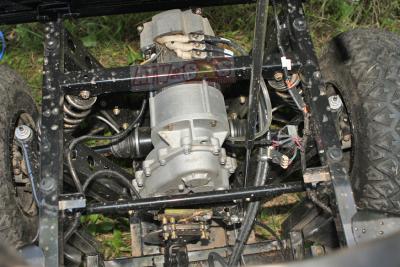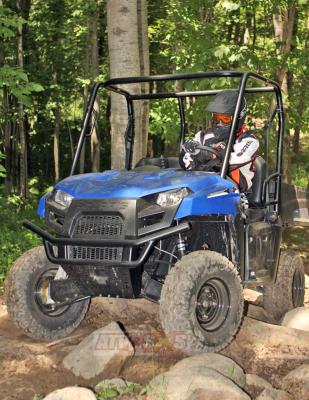From motorcycles to SUVs, every vehicle manufacturer has been experimenting with electric power systems. In this arena it would seem auto manufacturers like Honda have an enormous leg up, with years and even decades of research and actual electric vehicle production behind them. Still, it is often small companies with an overabundance of creative ideas that find new solutions to difficult problems. In the motorcycle world that company is ZERO MOTORCYCLES. They’ve taken on the challenge of creating an electric motorcycle that you would actually want to ride. That got the attention of the big-boys, and rather than reinvent the wheel, Polaris opted to form a working relationship with ZERO to create the next generation of electric UTV.
NOT THE FIRST ELECTRIC POLARIS
We say next generation because a decade ago Polaris introduced their first electric side x side, the Ranger EV, the first true electric UTV with serious off-road chops. Pretty much everything before the EV was a golf cart riding on oversized off-road tires, with a 6 pack-rack in the back. Suspension was usually very limited and 4wd was only a distant dream. That left an opportunity, and as usual, Polaris was there to answer it.
The Polaris EV opened the door to a whole new class of serious off-road vehicle. It was built on proven electric technology of the day, and with a 48-volt, 30 horsepower AC motor and bank of eight heavy duty batteries, the new EV offered a reliable, tried and true power source in the more than capable RANGER chassis. Everything about the chassis was extremely familiar, from its XP style bodywork, to its smooth riding suspension, to the tough rear dump box. This was the RANGER we had come to know and love. It would do anything most casual users needed, as long as you were careful about how far you roamed and didn’t mind tethering it to an outlet in your garage all-night.
From the driver’s seat and on the trail, the EV is completely like the rest of its internal combustion powered brothers, with the exception of a few controls. On the dash there is a “gear shift” button, (actually a button for Forward or Reverse) and a switch for the 4wd system, along with a battery power meter, and a switch to select High, Low, or Max power modes. All the driver needs to do is hit the “Forward” button and with foot-on-throttle you’ll be on your way. The EV picks up speed quickly, but then again, an electric motor has about as much hesitation as a light bulb and we should have expected excellent acceleration. Sprinting down the trail at a quick pace, the EV was every bit as predictable as any of the RANGERs, but it does have a few traits completely unlike any of its cousins. As we approached downed logs and a rocky section we backed off the throttle, but rather than rolling into the obstacles, we came to a silent stop just ahead of it. It felt exactly like we stalled it. Driving an electric vehicle with no engine feedback sound is a different experience and takes some getting used to. We pressed down on the throttle and over the logs and rocks we went. About the only noise you hear on the trail is a slight whine from the motor and driveline, and tire noise from sticks, leaves, trail debris, etc. As with most electric vehicles, the downfall is range. Projected range with the EV is about 50 miles depending on drive mode, terrain, and even cold weather, and that’s not enough for many, including us. We’ve heard stories about EVs with a generator (Honda – go figure) mounted in the back, and that’s not the kind of hybrid gas – electric system that would be acceptable going forward. The next electric Polaris will address many daunting design challenges.
NEXT GENERATION RANGER
Polaris has committed to building their next generation electric vehicle in a full-sized Ranger platform, and to be in production before the New Year. That creates some very tall hurdles to clear. Here is what we expect from the new Ranger:
- ITS ALL ABOUT THE BATTERY – Every electric vehicle manufacturer has come up against the physics of this problem. Packing it in the frame is the easy part, and without the constraints of a small, motorcycle chassis, ZERO might be able to get creative here. The tradeoff is that every pound of battery requires power to carry around as well.
- EXTENDED RANGE – This is by far the biggest challenge. It’s really a matter of how far you want to go between charges, and how much battery must be carried to meet that goal. A full-sized Ranger is no lightweight, and roughly 3 to 4 times more load than the Zero motorcycles. In addition, it must be able to haul and tow a heavy load over difficult, uneven terrain, and that all saps power. The motorcycle generally benefits from less rolling resistance of a paved surface. And nobody plows snow with a motorcycle in below zero conditions.
- ACCESSORY INTEGRATION – The Polaris accessory catalog is extensive. The new electric Ranger will accommodate much of it, if not all, but that creates secondary problems. Many accessories require power. Think about extra lights, cab heater, wiper motors, a stereo, the Ride Command system, a snow plow, and perhaps the biggest power draw of all, a winch. Winches already are so efficient at killing a fully charged battery it’s advisable to leave the engine running during use. An old-fashioned block and tackle might be the better option in a fully electric world.
- TIRE CHOICES – Again, it will be a mix of efficiency to conserve power. There is no doubt you’ll still be able to change out the stock tires to a larger size with a more aggressive tread pattern, but it will cost you in battery range.
- FAMILIAR PLATFORM – Polaris rarely designs a single use platform. They’re experts at creating parts that can be used across multiple models in a lineup. That’s excellent news for the new Ranger since the current full-sized Ranger is supremely comfortable and capable. Other than the motor and battery system, we expect the majority of components to be very familiar.
- MOTORS – Zero currently offers several motor options, including the 110 horsepower, 14 lb.-ft of torque, ZF75-10 motor which would provide plenty of power. However, since weight will be very important, a secondary and perhaps more likely option is the SF75-7 motor which brings 70 hp. That would provide ample torque for the majority of users.
- A NEW LOOK – Polaris only gave two teaser images with the announcement of the new electric Ranger. While it showed a slightly different front fascia, we expect these images were rather generic and more conceptual than headed for production. It’s likely the new model will look very much like its brothers in the Ranger lineup, but with a few styling cues to show it’s the EV. If nothing else, stickers and lack of a gas cap will give it away.
- A HYBIRD – Is a hybrid worth exploring? Some of the automotive manufacturers include a small engine to power a generator when needed, and this would definitely help with extended range and occasional peak draws, such as for plowing snow. It would not be unheard of either, as Kymco once had a UTV model with a generator and an entire electrical panel to power worksite tools, such as saws, portable compressors, etc.
- MULTIPLE MODEL CHOICES – Polaris loves to offer multiple trim and accessory packages with every model they make. There will likely be multiple options with the new electric model as well.
- PRICE – Currently the EV lists for just under $12k, while a Ranger NorthStar 1000 Ultimate is at $27k. Final pricing will be determined by the design direction Polaris takes. Should they decide to go all-out like with the NorthStar edition, pricing will be accordingly, but even at the low end we expect a base model to be well above the standard EV price. In fact, we would be surprised if it would be priced at less than $18k.
EV EVOLUTION
The Ranger EV took electrically powered off-road vehicles down a trail they had never been down before. Today you can bet every OEM is exploring an electric option, and some companies like Nikola are even entering the high-performance world of electric vehicles with high-end models. The new Ranger EV – if it is even to be called the EV – will once again break new ground for sportsman, homeowners, parks departments, cottage and vacation communities, beach patrols, and anywhere else a traditional Side x Side might not be welcome. Electric vehicles have always been here. Now they’re coming out of the shadows in a big way, and as long as the OEMS like Polaris can solve the problems of range and frequent charging, they’re here to stay.
*


